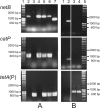Necrotic enteritis-derived Clostridium perfringens strain with three closely related independently conjugative toxin and antibiotic resistance plasmids
- PMID: 21954306
- PMCID: PMC3181468
- DOI: 10.1128/mBio.00190-11
Necrotic enteritis-derived Clostridium perfringens strain with three closely related independently conjugative toxin and antibiotic resistance plasmids
Abstract
The pathogenesis of avian necrotic enteritis involves NetB, a pore-forming toxin produced by virulent avian isolates of Clostridium perfringens type A. To determine the location and mobility of the netB structural gene, we examined a derivative of the tetracycline-resistant necrotic enteritis strain EHE-NE18, in which netB was insertionally inactivated by the chloramphenicol and thiamphenicol resistance gene catP. Both tetracycline and thiamphenicol resistance could be transferred either together or separately to a recipient strain in plate matings. The separate transconjugants could act as donors in subsequent matings, which demonstrated that the tetracycline resistance determinant and the netB gene were present on different conjugative elements. Large plasmids were isolated from the transconjugants and analyzed by high-throughput sequencing. Analysis of the resultant data indicated that there were actually three large conjugative plasmids present in the original strain, each with its own toxin or antibiotic resistance locus. Each plasmid contained a highly conserved 40-kb region that included plasmid replication and transfer regions that were closely related to the 47-kb conjugative tetracycline resistance plasmid pCW3 from C. perfringens. The plasmids were as follows: (i) a conjugative 49-kb tetracycline resistance plasmid that was very similar to pCW3, (ii) a conjugative 82-kb plasmid that contained the netB gene and other potential virulence genes, and (iii) a 70-kb plasmid that carried the cpb2 gene, which encodes a different pore-forming toxin, beta2 toxin.
Importance: The anaerobic bacterium Clostridium perfringens can cause an avian gastrointestinal disease known as necrotic enteritis. Disease pathogenesis is not well understood, although the plasmid-encoded pore-forming toxin NetB, is an important virulence factor. In this work, we have shown that the plasmid that carries the netB gene is conjugative and has a 40-kb region that is very similar to replication and transfer regions found within each of the sequenced conjugative plasmids from C. perfringens. We also showed that this strain contained two additional large plasmids that were also conjugative and carried a similar 40-kb region. One of these plasmids encoded beta2 toxin, and the other encoded tetracycline resistance. To our knowledge, this is the first report of a bacterial strain that carries three closely related but different independently conjugative plasmids. These results have significant implications for our understanding of the transmission of virulence and antibiotic resistance genes in pathogenic bacteria.
Figures





Similar articles
-
Conjugation-Mediated Horizontal Gene Transfer of Clostridium perfringens Plasmids in the Chicken Gastrointestinal Tract Results in the Formation of New Virulent Strains.Appl Environ Microbiol. 2017 Dec 1;83(24):e01814-17. doi: 10.1128/AEM.01814-17. Print 2017 Dec 15. Appl Environ Microbiol. 2017. PMID: 29030439 Free PMC article.
-
Functional analysis of a bacitracin resistance determinant located on ICECp1, a novel Tn916-like element from a conjugative plasmid in Clostridium perfringens.Antimicrob Agents Chemother. 2015 Nov;59(11):6855-65. doi: 10.1128/AAC.01643-15. Epub 2015 Aug 17. Antimicrob Agents Chemother. 2015. PMID: 26282424 Free PMC article.
-
Toxin plasmids of Clostridium perfringens.Microbiol Mol Biol Rev. 2013 Jun;77(2):208-33. doi: 10.1128/MMBR.00062-12. Microbiol Mol Biol Rev. 2013. PMID: 23699255 Free PMC article. Review.
-
Worldwide distribution of the conjugative Clostridium perfringens tetracycline resistance plasmid, pCW3.Plasmid. 1985 Jul;14(1):37-46. doi: 10.1016/0147-619x(85)90030-7. Plasmid. 1985. PMID: 2863833
-
Antibiotic resistance plasmids and mobile genetic elements of Clostridium perfringens.Plasmid. 2018 Sep;99:32-39. doi: 10.1016/j.plasmid.2018.07.002. Epub 2018 Jul 26. Plasmid. 2018. PMID: 30055188 Review.
Cited by
-
Influence of pCP1NetB ancillary genes on the virulence of Clostridium perfringens poultry necrotic enteritis strain CP1.Gut Pathog. 2017 Jan 21;9:6. doi: 10.1186/s13099-016-0152-y. eCollection 2017. Gut Pathog. 2017. PMID: 28127404 Free PMC article.
-
Animal models to study the pathogenesis of human and animal Clostridium perfringens infections.Vet Microbiol. 2015 Aug 31;179(1-2):23-33. doi: 10.1016/j.vetmic.2015.02.013. Epub 2015 Feb 25. Vet Microbiol. 2015. PMID: 25770894 Free PMC article. Review.
-
A Poultry Subclinical Necrotic Enteritis Disease Model Based on Natural Clostridium perfringens Uptake.Front Physiol. 2022 Jun 8;13:788592. doi: 10.3389/fphys.2022.788592. eCollection 2022. Front Physiol. 2022. PMID: 35795645 Free PMC article.
-
Antimicrobial Resistance in Clostridium and Brachyspira spp. and Other Anaerobes.Microbiol Spectr. 2020 Jan;8(1):10.1128/microbiolspec.arba-0020-2017. doi: 10.1128/microbiolspec.ARBA-0020-2017. Microbiol Spectr. 2020. PMID: 31971162 Free PMC article. Review.
-
Clostridium perfringens type A-E toxin plasmids.Res Microbiol. 2015 May;166(4):264-79. doi: 10.1016/j.resmic.2014.09.004. Epub 2014 Oct 2. Res Microbiol. 2015. PMID: 25283728 Free PMC article. Review.
References
-
- Petit L, Gibert M, Popoff MR. 1999. Clostridium perfringens: toxinotype and genotype. Trends Microbiol. 7:104–110 - PubMed
-
- Rood JI. 1998. Virulence genes of Clostridium perfringens. Annu. Rev. Microbiol. 52:333–360 - PubMed
-
- Smedley JG, III, Fisher DJ, Sayeed S, Chakrabarti G, McClane BA. 2004. The enteric toxins of Clostridium perfringens. Rev. Physiol. Biochem. Pharmacol. 152:183–204 - PubMed
-
- Kaldhusdal M, Hofshagen M. 1992. Barley inclusion and avoparcin supplementation in broiler diets. 2. Clinical, pathological, and bacteriological findings in a mild form of necrotic enteritis. Poult. Sci. 71:1145–1153 - PubMed
Publication types
MeSH terms
Substances
Associated data
- Actions
- Actions
- Actions
- Actions
Grants and funding
LinkOut - more resources
Full Text Sources
Medical
Molecular Biology Databases
Miscellaneous
